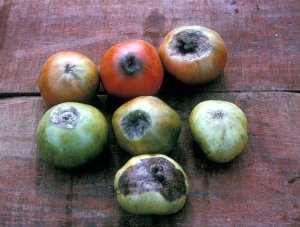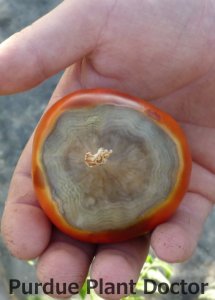Blossom-End Rot Frustrates Tomato Growers
Eager tomato growers, having lovingly nurtured their plants, anxiously await their ripe gems. But alas, a black, leathery spot appears at the base of the fruit.
Blossom end-rot is thankfully not an infectious disease, but rather a frustrating disorder of the fruit. The black scar tissue is thought to be caused by a deficiency of calcium in the developing fruit.
In most cases, blossom end-rot is brought on by extreme fluctuations in soil moisture. And this year we sure had extremes of rainfall, so blossom-end rot is likely to be prevalent.
The black or brown spot develops on the blossom-end of the fruit opposite the point of stem attachment, thus the name blossom-end rot. The scar is usually firm and leathery, although secondary rot organisms may enter through the damaged tissue, causing a soft rot to develop. Often it’s the early forming fruit that are affected, but it can happen anytime.
Tomatoes aren’t the only species affected by blossom-end rot; peppers, summer squash, and other cucurbit plants can also be afflicted.
There is no spray that will control blossom-end rot, except maybe from the irrigation hose. Some folks recommend spraying the plants with calcium, but by the time you see the scar on the fruit, it is too late. Most Indiana soils have plenty of calcium, although some sandy soils may be deficient.
Watering during dry spells and mulching to conserve soil moisture will help reduce the fluctuations in soil moisture and thus encourage steady growth and calcium supply in the fruits.
Although the fruits that have already developed the scar cannot be helped, the new developing fruits can be. You can cut away the affected portion of the fruit and use the rest, but avoid using any damaged fruits for canning.
Yard & Garden Calendar – September 2020
YARD (Lawns, woody ornamentals and fruits)
Fall is a good time to plant many container-grown or balled-and-burlapped nursery stock. Prepare a good-size planting hole wider than the ball, but plant at the same depth it grew in the nursery and water thoroughly. Mulching will help protect against large fluctuations in soil temperature and moisture.
Do not be alarmed if your evergreens, particularly white pine and arborvitae, drop some older needles. All evergreens shed needles at some time, but not all at once as deciduous plants do.
Harvest apples, pears, grapes, and everbearing strawberries and raspberries. For most fruits, flavor is the best indicator of ripeness, although color change also can be a good indicator. However, pears are best ripened off the tree, and grapes change color long before they are fully flavored, so sample the fruit to be sure.
Remove raspberry canes after they bear fruit.
Clean up fallen fruits, twigs and leaves around apple (including crabapple) and other fruit trees to reduce disease and insect carryover.
To promote the lawn’s recovery from summer stress, apply high-nitrogen fertilizer at the rate of 0.5 to 1 pound actual nitrogen per 1,000 square feet. More information on lawn fertilization is available at https://mdc.itap.purdue.edu/item.asp?item_number=AY-22-W
Reseed bare spots or new lawns using a good-quality seed mixture. Seeding in late summer allows the turf to maximize its establishment and rooting prior to the next summer’s heat and drought. For more information, see http://purdueturftips.blogspot.com/2014/08/start-seeding-cool-season-turf-now.html
September and October are appropriate months to apply broadleaf weed killers to the lawn. Be sure to follow all label directions, and choose a calm day to prevent spray drift.
GARDEN (Flowers, vegetables and small fruits)
Dig onions and garlic after tops fall over naturally and necks begin to dry.
Plant radishes, green onion sets, lettuce and spinach for fall harvest.
Thin fall crops, such as lettuce and carrots, that were planted earlier.
Harvest crops such as tomatoes, peppers, eggplants, melons and sweet potatoes before frost, or cover plants with blankets, newspaper, etc., (but not plastic) to protect them from light frost.
Mature green tomatoes can be ripened indoors. Individually wrap fruits in newspaper, or leave them on the vine, pulling the entire plant out of the garden. Store in a cool location – about 55-60ºF.
Harvest winter squash when mature (skin is tough) with deep, solid color, but before hard frost. Some cultivars will show an orange blush when mature.
Plant, transplant or divide peonies, daylilies, iris and phlox only if you can apply irrigation during dry spells.
Save plants such as coleus, wax begonias, impatiens or fuchsia for indoor growing over winter. Dig plants and cut them back about halfway, or take cuttings of shoot tips, and root them in moist vermiculite, soil mix or perlite.
Watch for garden chrysanthemums to bloom as days grow shorter. Some may have bloomed earlier this summer, which will decrease the number of fall blooms.
Plant spring-flowering bulbs beginning in late September. Planting too early can cause bulbs to sprout top growth before winter. However, allow at least four to six weeks before the ground freezes for good root formation.
Dig tender bulbs, such as cannas, caladiums, tuberous begonias and gladiolus, before frost. Allow to air dry, and store in dry peat moss or vermiculite.
HOME (Indoor plants and activities)
Prepare storage areas for overwintering tender flower bulbs and garden produce.
Thanksgiving (or Christmas) cactus can be forced into bloom for the Thanksgiving holidays. Provide 15 hours of complete darkness each day, for instance, from 5 p.m. to 8 a.m., for approximately eight weeks. Keep temperature at about 60-65 degrees F. Temperatures of 55°F will cause flower buds to set without dark treatment.
Dig and repot herbs, or take cuttings, for growing indoors over winter.
Store leftover garden seed in a cool, dry place. A sealable jar with a layer of silica gel or powdered milk in the bottom works well.
Bring houseplants moved outside for summer indoors before night temperatures fall below 55°F. Gradually decrease light to acclimate the plants and help reduce leaf drop. Check and control insects and diseases before putting these plants near other houseplants.
Poinsettias saved from last year can be re-flowered for this year’s holiday by providing complete darkness for 15 hours daily from about Oct. 1 until about Dec. 10.


